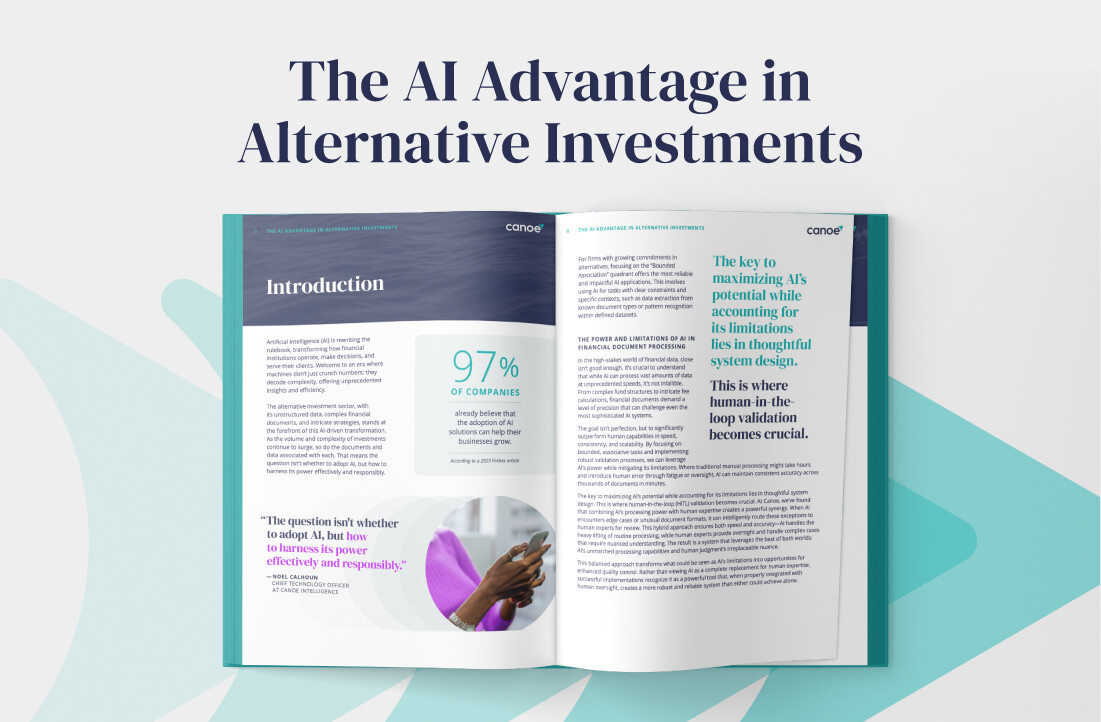Financial Statement Data Gold: How Access to Fund-Level Data Reveals New Possibilities for Alternative Investors
For many alternative investors, every quarter-end kicks off a frenzy of highly manual document and data workflows. The end game of this effort is to produce client reports as quickly and completely as possible. However, due to the illiquid nature of alternative investments, accurate and timely data for performance, reporting, and analysis continues to be elusive for all market participants.
Some of the documents needed for quarterly reporting include capital call notices, distribution notices, and account statements, as well as K-1s, factsheets, quarterly financials, performance estimates, manager letters, and more. Traditionally, it has been labor-intensive to locate these documents from email inboxes, portals, and other sources. Furthermore, successfully extracting, validating, and formatting the pertinent data from each document requires an all-hands-on-deck approach.
If you are doing this manual work today, you probably recognize that it’s extremely difficult if not impossible to assess trends over time and bring scale to your team’s efforts. Moreover, you may be missing out on other opportunities with this rich data.
Easy Access to Fund-Level Data
In recent years, financial technology companies like Canoe have helped firms reduce this ongoing, quarterly burden by introducing sophisticated automation into their workflows. Now, we also support other, more complex document types like quarterly financial statements.
Quarterly financial statements typically include a variety of sub-documents such as balance sheets, income statements, statements of cash flows, schedules of investments, and notes. In some cases, clients will receive separate year-end audited financial statements. These documents tend to have many pages and include content with specific data hierarchies, taxonomies, and structures that make data extraction more complex and nuanced.
Canoe has trained its shared intelligence to extract fund-level data at scale from financial statements, in the same way it’s been extracting data from other types of documents. Now, clients can access this rich fund-level data at their fingertips for more downstream applications.
New Use Cases for Fund-Level Data
While some data within financial statements is not mission-critical on its own, combining it with other data opens up new possibilities for more accurate reconciliation, portfolio tracking and monitoring, and fund due diligence.
Reconciliation Workflows
If your firm is processing and gathering quarterly financial statement information today, you can significantly streamline this collection and processing workflow through automation.
- Understand valuations and fund ownership with more granularity and ensure the financial statements tie out.
- Obtain the data to run waterfall calculations with ease.
- Run fee analyses to assess how GPs are booking fees at the fund level and understand any disparities in the fees you are being charged.
Having access to this information could become a competitive advantage in improving your ability to negotiate management fees going forward.
Portfolio Tracking and Monitoring of Existing Funds
If you are currently tracking and monitoring funds manually, you can automate access to fund-level data to improve transparency and reporting flexibility while reducing operational overhead.
- Improve your ability to extract data and report on it effectively.
- Immediately identify patterns, changes, and red flags.
- Validate the information you’re receiving from your managers.
Having access to this information allows you to understand the efficacy of your investments in a more granular way, exactly aligned to your business goals while reducing the costs associated with manual labor.
Fund Due Diligence
If you are looking to acquire a secondaries interest in a fund or commit to a new fund, you can significantly streamline your diligence process.
- Analyze and monitor existing fund commitments to ensure fund manager performance and positioning are in line with expectations.
- Assess the performance of prior vintage funds to support investment decisions for new or follow-on commitments.
- Seamlessly execute diligence on secondaries deals to expedite transactions.
Having access to fund-level information enables you to more efficiently analyze historical performance and behavior of current and prior funds.
Conclusion
By providing easy access to your fund-level quarterly financial statement data, we’re opening up possibilities for new workflows, deeper analysis, and added client value.
Typically, firms are receiving financial statements more than a month after quarter-end and then must begin extracting relevant data from those statements. This time lag in access to documents causes client reporting to be further delayed. With access to fund-level data through Canoe, you can extract data from these documents as you receive them, significantly accelerating the time to value for firms. And, if you are not leveraging this data today, you can now have easy access to it for improved reconciliation, portfolio tracking and monitoring, fund due diligence, and many more valuable use cases.
Explore how your firm could benefit from access to fund-level data. Request a demo today!



